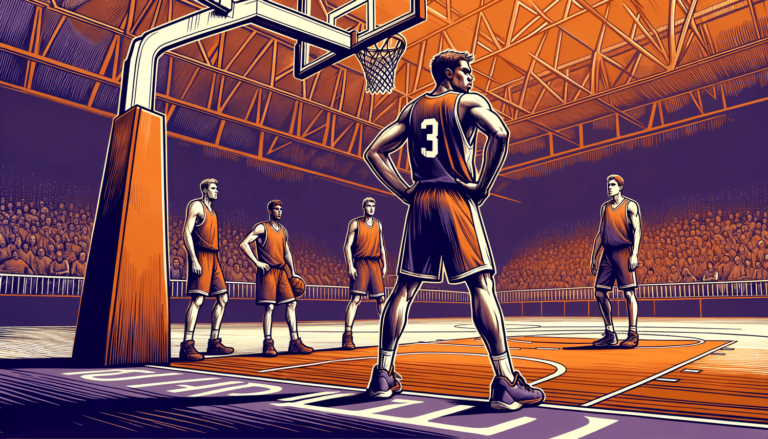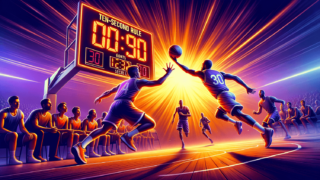
Offensive Three-Second Violation in Basketball
Written by: Basketball Universe
Last updated:

For those who thrive on the details of basketball, understanding the offensive three-second violation is just as gripping as watching a nail-biting game with a last-second shot! Get ready to take a deep dive into the intricacies of this rule, as we navigate the confined yet crucial realms of the painted area where giants jostle, hustle and even get tangled. Whether you’re an avid fan eager to expand your knowledge or a budding player looking to sharpen your skills, grab some popcorn and get comfortable as we break down this fundamental aspect of basketball in a fun and professional manner. Welcome to the world of the offensive three-second violation!
Offensive Three-Second Violation in Basketball
The offensive three-second violation in basketball occurs when an offensive player remains in the restricted area, also known as the key or the paint, for more than three consecutive seconds without actively engaging in the play. This results in a turnover, and the opposing team takes possession of the ball. The purpose of this rule is to prevent bigger offensive players from excessively dominating the area near the basket and to maintain a fair and fluid gameplay.
Deciphering the Key: Exploring the Restricted Area
Before we dive into the intricacies of the offensive three-second violation, it’s important to understand the landscape of the basketball court, particularly the “restricted area” where this rule is enforced. Also known as the “key” or the “paint,” this area of the court is a rectangular space extending from the baseline to the free-throw line and is marked by distinct lines on both sides. The restricted area holds great significance in the game of basketball, as it is where the battle for rebounds, layups, and post plays take place.
Breaking Down the Basics of the Offensive Three-Second Violation Rule
The foundation of the offensive three-second violation lies in the spirit of maintaining fair play and a dynamic game. Enforced in both professional and amateur leagues, this rule prevents offensive players from gaining an unfair advantage by lingering too long in a prime scoring position. So, what exactly constitutes a violation?
Understanding the Countdown
An offensive player violates the three-second rule if they remain in the restricted area for more than three consecutive seconds while their team possesses the ball. The countdown begins when the player establishes both feet inside the key and pauses once they leave the area or become actively engaged in the play. If a shot is attempted and the ball hits the rim, the three-second count resets for all players in the key. In summary, to avoid committing this violation, offensive players must either vacate the key, engage in a play, or hope the ball hits the rim within three seconds of their entry.
Crucial Scenarios to Keep in Mind
Various in-game situations can impact the offensive three-second violation count. It’s essential to be aware of these specific scenarios for both players and fans eager to stay informed about the nuances of basketball rules.
Shot Attempts and Rebounds
When a teammate attempts a shot and the ball is in the air, the three-second count is temporarily on hold. Once the ball either hits the rim, enters the basket, or is secured by an opposing player following a missed shot, the count resumes. If the shot misses and an offensive player grabs the rebound, they must immediately vacate the key or actively engage in a play to avoid a violation.
Free Throws and Inbounds
During free-throw situations or inbounds plays, the offensive three-second count does not apply until the ball is legally inbounded and touched by a player on the court. This allowance gives a short grace period for offensive players to establish position without violating the rule.
Spotting the Violation and its Consequences
Anyone watching the game, players, coaches, and fans alike, should know the subtle indicators of an offensive three-second violation and the subsequent consequences of this infraction.
Identifying the Violation
Referees are responsible for identifying and calling the offensive three-second violation during gameplay. They continuously monitor the key area, utilizing both their peripheral vision and a mental countdown to track players’ movements. When the referee signals the infraction, they blow the whistle and form a “T” shape with their hands, denoting the three-second count.
Penalties for Violation
When an offensive three-second violation is called, the game pauses, and a turnover is enforced. The offending team loses possession of the ball, and the opponents receive it via a throw-in from the sideline. This can be a costly consequence, as lost possessions often lead to points for the opposing team, making the understanding and avoidance of this infraction a priority for all offensive players.
Strategies to Avoid the Offensive Three-Second Violation
Mastery of the offensive three-second rule not only prevents turnovers but also helps optimize offensive strategies. Here’s how players and teams can ensure they stay on the right side of this essential basketball rule:
1. Develop Court Awareness and Basketball IQ
Having a keen sense of time and space is critical to avoiding the offensive three-second violation. Committing to regular practice and focusing on improving your Basketball IQ will help develop a natural sense of how long three seconds last and how that translates into your movement on the court.
2. Establish Proper Spacing
Good offensive spacing creates opportunities for one-on-one matchups, prevents clogging near the basket, and minimizes the risk of committing an offensive three-second violation. Players should focus on spacing during offensive sequences, ensuring they don’t linger too long in the key while positioning themselves for potential plays.
3. Embrace Off-Ball Movement
Active off-ball movement is an effective way to steer clear of three-second violations. By cutting, screening, and staying in motion, players can avoid staying stagnant in the key and contribute to creating scoring opportunities for the team.
4. Communicate With Teammates
Communication is the cornerstone of team synergy in basketball. Encouraging verbal and non-verbal communication among teammates can help alert players who may be at risk of committing an offensive three-second violation, enabling them to reposition or engage in a play before the infraction occurs.
Unraveling the Mystery of the Offensive Three-Second Violation
With these insights, the seemingly complex realm of the offensive three-second rule becomes much more accessible. Understanding its foundation, scenarios, consequences, and strategies for avoidance can dramatically impact players’ abilities on the court and enrich the knowledge of basketball enthusiasts.
A Vital Piece of the Basketball Rules Puzzle
Ultimately, the offensive three-second violation is one of the many essential basketball rules that contribute to the game’s dynamic and strategic nature. Embracing both the simplicity and complexities of this rule is crucial for teams and players seeking to enhance their performance and for fans eager to dissect the many fascinating elements of the game.
Common Misconceptions about the Offensive Three-Second Violation
Despite being a fundamental basketball rule, there are common misconceptions surrounding the offensive three-second violation. Expanding your knowledge on this topic will further enhance your understanding of the game and help dispel any misguided beliefs about the rule.
Myth: The Three-Second Count Begins with One Foot Inside the Key
Contrary to popular belief, the offensive three-second count only starts when a player establishes both feet inside the key. Simply having one foot inside the area does not initiate the countdown.
Myth: Offensive Players Cannot Re-enter the Key after Exiting
There is no restriction on the number of times a player may enter and exit the key during an offensive possession. As long as players do not exceed the allowed three seconds while inside, they may continue to move in and out of the restricted area as needed.
History of the Offensive Three-Second Rule
The history behind the offensive three-second rule traces back to the early days of basketball and is intrinsically linked with the evolution of the sport. Gaining a historical perspective on this rule brings a greater appreciation for its lasting impact on shaping the game we know and love today.
Origin and Rationale
The origins of the offensive three-second rule date back to 1936 in the United States. Basketball’s founding father, Dr. James Naismith, introduced this rule to prevent players from monopolizing the space under the basket. The primary rationale for implementing the rule was to ensure teams relied on more than just their tallest players to score and to promote the importance of ball movement.
Adaptation and International Recognition
Over time, the offensive three-second rule caught on in basketball leagues worldwide. The International Basketball Federation (FIBA) adopted the rule for its member leagues, solidifying the universality of this foundational principle in the sport. Today, the rule is enforced across all major and minor basketball leagues, ensuring a consistent experience for players and fans alike.
Comparison with the Defensive Three-Second Violation
While the focus of this article is the offensive three-second violation, it is essential to recognize its counterpart, the defensive three-second violation, and understand their distinct differences.
Defensive Three-Second Violation Basics
The defensive three-second violation occurs when a defensive player remains inside the key for more than three consecutive seconds without actively guarding an opponent. This rule is intended to prevent defenders from clogging up the paint and restrict excessive zone defense deployment. Unlike the offensive violation, the defensive three-second violation results in a technical foul, and the opposing team is awarded a free throw attempt.
Contrasting the Two Violations
While both offensive and defensive three-second violations share the same countdown principle and are focused on the same area of the court, they differ significantly in their consequences and purpose. The offensive violation prevents tall players from dominating the area near the basket, while the defensive counterpart prevents illegal zone defense tactics. Additionally, the penalties for each infraction differ, with the offensive three-second violation resulting in a turnover, while the defensive violation leads to a technical foul and a free-throw attempt.
Frequently Asked Questions about the Offensive Three-Second Violation
If you’re still curious about the nitty-gritty details of the offensive three-second violation or want some quick answers to common questions, this FAQ section is here to help. We have compiled a list of ten frequently asked questions with concise, easily digestible answers to further enhance your understanding of this critical basketball rule.
1. What is the offensive three-second violation?
The offensive three-second violation occurs when an offensive player remains in the key, or the restricted area, for more than three consecutive seconds without actively engaging in a play when their team possesses the ball.
2. Why is the offensive three-second rule important?
This rule is important because it prevents offensive players from gaining an unfair advantage by lingering in the restricted area near the basket. It maintains fair play and ensures that the game remains fluid and dynamic.
3. What is the penalty for committing an offensive three-second violation?
The penalty for committing an offensive three-second violation is a turnover. The offending team loses possession of the ball, and the opposing team takes possession via a throw-in from the sideline.
4. How do referees signal an offensive three-second violation?
When referees detect an offensive three-second violation, they blow their whistle and form a “T” shape with their hands, indicating the three-second count.
5. Does the offensive three-second rule apply during free throws or inbounds plays?
The offensive three-second rule does not apply during free-throw situations or inbounds plays until a player on the court legally touches the inbounded ball.
6. What happens to the three-second count when a shot is attempted?
When a shot is attempted, the three-second count is temporarily paused. The count resumes once the ball either hits the rim, enters the basket or is secured by the opposing team following a missed shot.
7. How can players avoid committing an offensive three-second violation?
Players can avoid committing an offensive three-second violation by remaining aware of their position on the court, maintaining proper spacing, engaging in regular off-ball movement, and communicating with their teammates during offensive possessions.
8. When does the offensive three-second count start?
The offensive three-second count starts as soon as a player establishes both feet inside the key while their team possesses the ball.
9. Is the offensive three-second rule enforced in all basketball leagues?
Yes, the offensive three-second rule is enforced across all major and minor basketball leagues, including the NBA, WNBA, NCAA, FIBA and amateur organizations.
10. How is the offensive three-second violation different from the defensive three-second violation?
While both violations involve a three-second count in the key, the offensive violation focuses on preventing tall players from dominating the area near the basket, while the defensive violation prohibits illegal zone defense tactics. The penalties also differ, with the offensive violation resulting in a turnover and the defensive violation leading to a technical foul and a free-throw attempt.
Featured Posts
- No pillar pages found.





